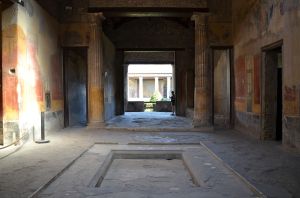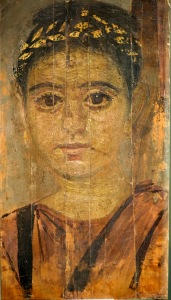 “Today, dear God, I am seven years old, and must play no more. Here is my top, my hoop, and my ball: keep them all, my Lord.” (Wiedemann, 1989)
“Today, dear God, I am seven years old, and must play no more. Here is my top, my hoop, and my ball: keep them all, my Lord.” (Wiedemann, 1989)

Roman children, from newborn to seven years old, were allowed to frolic and play with toys, games and each other. No matter their station, slave and freed children alike, played with toys in various forms, and organized games with groups of friends.
Thomas Wiedmann, in Adults and Children in the Roman Empire, describes little rattles that were given to young babies, made of metal or pottery with pebbles inside, and strings with objects tied to it that a child could hold and carry for manipulation and visual stimulation. There was also a kind of walker with wheels, that a child could lean on and push, to learn to walk with. (Wiedemann, 1989)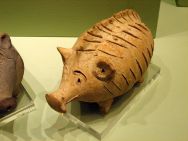
Older children would build sandcastles, roughhouse and wrestle, play house, and all sorts of games. The games often involved nuts, animals and even a bit of gambling. Bets could be placed on cock fights, a popular pastime for older boys, though it was condemned as a greedy pastime for the lazy. In Leisure and Ancient Rome, J.P. Toner describes a game table with the inscription “Reject wealth, insane greed flips minds.” (Toner, 1995) Uzzi, in Children in the Visual Arts of Imperial Rome, depicts a mosaic showing two boys engaged in a cock fight. The winner dances and the loser covers his face in shame. (Uzzi, 2005, pp. 186,187)
Many of the games included role playing, with one group taking on the role of bad-guy and one the victor. Children would reenact their favorite scenes from history or fables told to them by their parents. Parents might encourage a future career in the military by purchasing a little military uniform for their child to parade around in playing soldier. (Wiedemann, 1989)
They also enacted various societal roles, a judge and criminal, or even monks and demons. It was considered to be a great omen when Athanasius, who later became a great theologian, was elected as head bishop when he role played with his friends as a child.
All children loved to play at riding horses, starting with a broomstick and moving up to driving small chariots with goats and sheep, even mice. Toy chariots would be hitched to mice which were kept as pets.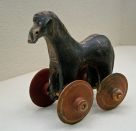
Pets were popular among children, as animal herding was considered to be a useful skill for a child to know. A child might combine gambling with their pets, as rooter fighting was common. Birds were the most commonly owned pet, but there is also mention of children keeping cheetahs and other exotic creatures.
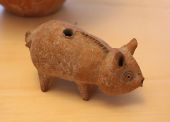 They also had toy animals made of terracotta, bone or even horn. A child might have a toy cow, pig, deer, goat or horse along with a tiny chariot for them each to pull. Girls were given dolls to play with, made of wood, rags, or ivory. Some were jointed so that they could move. Some were given jobs to do, for example pounding out bread.
They also had toy animals made of terracotta, bone or even horn. A child might have a toy cow, pig, deer, goat or horse along with a tiny chariot for them each to pull. Girls were given dolls to play with, made of wood, rags, or ivory. Some were jointed so that they could move. Some were given jobs to do, for example pounding out bread.
Dolls were an important part of a girl’s life, and were often buried with them depicted on their sarcophagi and sometimes even buried with a little girl that had died before reaching adulthood. Roman girls would dedicate their dolls to Venus the night before their wedding, marking their passage from childhood into adulthood.
Fanny Dolansky, in “Playing with Gender; Girls, Dolls, and Adult Ideals in the Roman World,” stated that since dolls were presented in Roman society as specifically girl’s toys, they portray an accurate view of a girl’s role in society. The dolls had fashionable hair and mature sexual organs, and depict someone of marriageable age. Dolansky stated that because the dolls were representations of mature women, this indicates that the dolls were used to model a girl’s role as a wife and mother.
Dolansky used Plutarch’s description of his daughter playing with her dolls to prove her point. Plutarch’s daughter “would ask her nurse to feed not only other babies but the objects and toys that she liked playing with, and would generously invite them, as it were, to her table, offering the good things she had and sharing her greatest pleasures with those who delighted her. (Dolansky, 2012)
The role of children within the Roman Empire is unclear and subject to much interpretation. Simon P Ellis, in Roman Housing, proposes the argument that children were to behave like adults, citing funerary depictions of children engaged in adult activities as well as the lack of space dedicated solely to children within the home. He describes children shunted to the sides and shadows of a room, similar to servants. (Ellis, 2000, pp. 178,179)
However, Jeannine Uzzi, in Children in the Visual Arts of Imperial Rome, describes a funerary relief of a little girl with a book in her lap and a dog at her feet that “implores her to forget her learning and go out to play.” (Uzzi, 2005, p. 175)
Penelope Allison, in Pompeian Households, An Analysis of Material Culture, suggests that Pompeiian households may have been separated by gender and time of day, but not by age. The men seem to occupy the front hall of the house during the morning, the women would occupy that same space during the afternoon. (Allison, 2004)
Ellis makes a clearer argument using examination of adoption papers, wills and leases, through which is can be determined that Roman homes were occupied not by extended families, but the nuclear family. Parents slept nearby their children. Ellis describes the function of each room within a Pompeiian Villa, with a smaller child’s bed placed next to an adult sized bed, indicating that parents (or possibly a tutor) and children slept together in the same room. (Ellis, 2000)
Although the role of children within Roman society is subject to interpretation, it is clear, through funerary inscriptions, mosaics, furniture arrangements and toys, that children in the Roman Empire lived a similar life to modern day childhoods. There is something universal in a childhood full of toys, playing with dolls, riding stick horses and dressing up in military uniforms to play pretend.
Bibliography
Allison, P. M. (2004). Pompeian Households, An Analysis of Material Culture. Los Angeles: University of California.
bot, F. u. (n.d.). Little horse on wheels. Retrieved from http://commons.wikimedia.org/wiki/File:Little_horse_on_wheels_(Ancient_greek_child%27s_Toy).jpg
Dolansky, F. (2012). Playing with Gender; Girls, Dolls and Adult Ideals in the Roman World. Classical Antuity, 31(2), 256-296. Retrieved from http://www.jstor.org/stable/10.1525/CA.2012.31.2.256 .
Ellis, S. P. (2000). Roman Housing. London: Gerald Duckworth.
Jastrow. (n.d.). Doll. Palazzo Massimo, Rome. Retrieved April 30, 2015, from http://commons.wikimedia.org/wiki/File:Doll_Massimo_Inv168191.jpg
Jastrow. (n.d.). Toy buffalo Louvre . Paris. Retrieved April 30, 2015, from http://commons.wikimedia.org/wiki/File:Toy_buffalo_Louvre_Cp4699.jpg
Montrealais. (n.d.). Roman-toys. Retrieved from http://commons.wikimedia.org/wiki/File:Roman-toys.jpg
Mountain. (n.d.). Rattle in the shape of animal. Museum of Cycladic Art at Athens, Greece. Retrieved from http://commons.wikimedia.org/wiki/File:Rattle_in_the_shape_of_animal.jpg
Sailko. (n.d.). Arte romana, giocattolo in terracotta a forma di suino. Retrieved from http://commons.wikimedia.org/wiki/File:Arte_romana,_giocattolo_in_terracotta_a_forma_di_suino,_I_sec_dc..JPG
Toner, J. P. (1995). Leisure and Ancient Rome. Cambridge: Polity Press.
Uzzi, J. D. (2005). Children in the Visual Arts of Imperial Rome. New York: Cambridge University Press.
Wiedemann, T. (1989). Adults and Children in the Roman Empire. New Haven: Yale University Press.

 “Today, dear God, I am seven years old, and must play no more. Here is my top, my hoop, and my ball: keep them all, my Lord.” (Wiedemann, 1989)
“Today, dear God, I am seven years old, and must play no more. Here is my top, my hoop, and my ball: keep them all, my Lord.” (Wiedemann, 1989)


 They also had toy animals made of terracotta, bone or even horn. A child might have a toy cow, pig, deer, goat or horse along with a tiny chariot for them each to pull. Girls were given dolls to play with, made of wood, rags, or ivory. Some were jointed so that they could move. Some were given jobs to do, for example pounding out bread.
They also had toy animals made of terracotta, bone or even horn. A child might have a toy cow, pig, deer, goat or horse along with a tiny chariot for them each to pull. Girls were given dolls to play with, made of wood, rags, or ivory. Some were jointed so that they could move. Some were given jobs to do, for example pounding out bread.

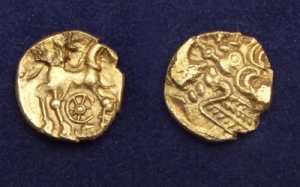


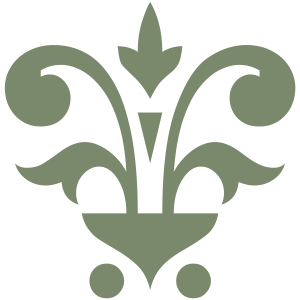


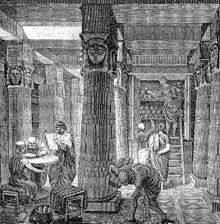






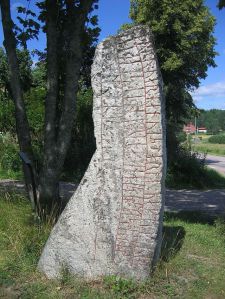



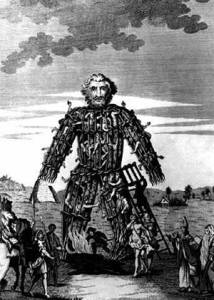



 at first but later was bestowed on local governors that got their power from the ruler. These vessels were used in sacrificial offerings of food and wine given to the ancestors. These bronze vessels were given different shapes depending on their use in sacrificial rites. Some of them are the li a round body with a base that extends into three hollow legs. The Ding a hemispheric body on three solid legs. The Fang ding which is a square vessel on four legs. The gui which is a bowl placed on a ring shaped foot. These ones were for food for wine you have the You a covered bucket with a handle jue a small beaker on three legs and many others used for both wine and food. The bronze vessels were not cast by the lost wax
at first but later was bestowed on local governors that got their power from the ruler. These vessels were used in sacrificial offerings of food and wine given to the ancestors. These bronze vessels were given different shapes depending on their use in sacrificial rites. Some of them are the li a round body with a base that extends into three hollow legs. The Ding a hemispheric body on three solid legs. The Fang ding which is a square vessel on four legs. The gui which is a bowl placed on a ring shaped foot. These ones were for food for wine you have the You a covered bucket with a handle jue a small beaker on three legs and many others used for both wine and food. The bronze vessels were not cast by the lost wax  method as was used in much of the world in the Shang dynasty but instead in something called sectional molds they would form clay around a core and sliced into sections then removed then fired and reconstructed around a smaller core that will make the hollow center of the vessel using metal spacers to separate them and the bronze is poured into the gap. Appendages such as leg and handles etcetera were usually cast separately. Designs could be added by adding designs to the clay mold. The ritual vessels ranged in height from 15 cm to 130 cm with the intricacy and sharpness of the designs Chinese level of bronze casting was extremely advanced. Many animals show up on Shang dynasty bronzes such as a tiger, cicada, snake, or owl it is not known if the animals have any particular meaning or if they are just on there for decoration
method as was used in much of the world in the Shang dynasty but instead in something called sectional molds they would form clay around a core and sliced into sections then removed then fired and reconstructed around a smaller core that will make the hollow center of the vessel using metal spacers to separate them and the bronze is poured into the gap. Appendages such as leg and handles etcetera were usually cast separately. Designs could be added by adding designs to the clay mold. The ritual vessels ranged in height from 15 cm to 130 cm with the intricacy and sharpness of the designs Chinese level of bronze casting was extremely advanced. Many animals show up on Shang dynasty bronzes such as a tiger, cicada, snake, or owl it is not known if the animals have any particular meaning or if they are just on there for decoration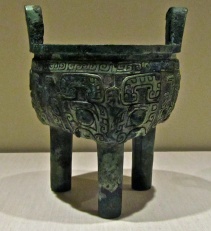 own flare and experimented with the techniques with a not as impressive result in my opinion. First of all the vessels for the ancestors began to become vehicles for accomplishments by the late Zhou vessels could have well over 400 characters on it.
own flare and experimented with the techniques with a not as impressive result in my opinion. First of all the vessels for the ancestors began to become vehicles for accomplishments by the late Zhou vessels could have well over 400 characters on it.  The vessel designs themselves became heavy and sagging and the quality of the casting was significantly lower than the late Shang bronze. After 771 they show signs of a renaissance per say. The bronze vessels were often adorned with bold handles in the form of animal heads a little later it changes to a more elegant form with more elaborate patterns such as interlaced serpents.
The vessel designs themselves became heavy and sagging and the quality of the casting was significantly lower than the late Shang bronze. After 771 they show signs of a renaissance per say. The bronze vessels were often adorned with bold handles in the form of animal heads a little later it changes to a more elegant form with more elaborate patterns such as interlaced serpents. orchestral set of 64 bells
orchestral set of 64 bells  found in a royal tomb of the Zeng state . These orchestral bells are on wooden rack supported by bronze human figures. It is kind of like the huge xylophone of the ancient world the bells go from about 20cm small to 150cm height. With their shape and how you strike them each of these bells can produce two completely different tones gold inscriptions on the bell even tell some of the musical terms. Bronze mirrors were also used not just as a thing to look at yourself in but as a funerary object the mirrors were often polished on the face and elaborately decorated on the back in a refined and elegant way.
found in a royal tomb of the Zeng state . These orchestral bells are on wooden rack supported by bronze human figures. It is kind of like the huge xylophone of the ancient world the bells go from about 20cm small to 150cm height. With their shape and how you strike them each of these bells can produce two completely different tones gold inscriptions on the bell even tell some of the musical terms. Bronze mirrors were also used not just as a thing to look at yourself in but as a funerary object the mirrors were often polished on the face and elaborately decorated on the back in a refined and elegant way.



